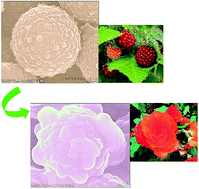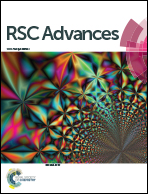Superhydrophobic polysilsesquioxane/polystyrene microspheres with controllable morphology: from raspberry-like to flower-like structure†
Abstract
Superhydrophobic polysilsesquioxane/polystyrene microspheres with raspberry-like to flower-like structure were fabricated via a cetyltrimethyl ammonium bromide (CTAB)-assisted sol–gel approach. The structure of nanoparticles on microcores could be controlled precisely by simply adjusting the content of the silane precursor: with increasing amount of silane precursor, the microspheres transformed from raspberry- to flower-like morphology. Besides the silane precursor, ammonia solution, CTAB and polyvinylpyrrolidone (PVP) also play essential roles in the formation of uniform and monodisperse hierarchical particles. The morphology, microstructure, and constitution of the microspheres were characterized by field-emission scanning electron microscopy (FE-SEM), transmission electron microscopy (TEM), Fourier transform infrared (FT-IR) spectroscopy, solid state 29Si magic angle spinning nuclear magnetic resonance (NMR) spectroscopy and X-ray diffraction (XRD). The formation mechanism of the hierarchical structure was also investigated in detail by time-dependent experiments. In addition, the particulate films, without any surface modification, showed superhydrophobic properties after simply assembling these hierarchical particles on glass substrates. The hierarchical morphology combined with the initial ethyl groups on the polysilsesquioxane materials were thought to be the main reason leading to this superhydrophobicity.



 Please wait while we load your content...
Please wait while we load your content...